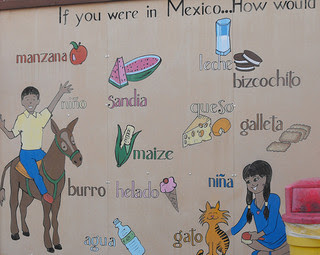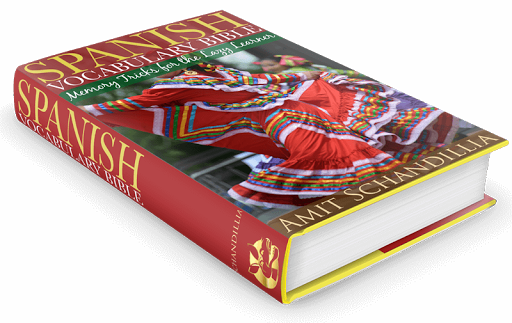Let’s attempt to answer all these questions and more here. In essence, it all boils down to the number of Spanish words one must be thoroughly acquainted with in order to achieve a certain level of proficiency in the language. But before we venture into the complex world of “word-frequency”, we need to understand a few definitions.
What is a word?
Just a string of letters? Well, yes and no. Of course any meaningful string of letters is a word by definition but for the purpose of our discussion we need to establish which words count and which don’t. Some linguists use the term, “lexemes” to define this situation. We, in keeping with our undying principle of jargon-free simplicity, stick to “words”.
 |
| A small Spanish vocabulary is enough for most purposes Photo credit: Jennifer Morton licensed CC BY-ND 2.0 |
Here, even though there might be one word for both scenarios, there’s a well-defined difference in their usage and they may or may not have the same equivalent in another language. They carry different senses. For the purpose of this discussion, they are two different words despite their exactly similar spellings – walk, the verb and walk, the noun. The word, “walk” in two different scenarios is technically said to be two different “lexemes”.
Similarly, let’s take “walk”, the verb. Does that just imply the form, “walk”? Or, does it also include “walked”, “walks”, etc.? Strictly speaking, they are all different words and yet the same lexeme, “walk”. So, for the sake of simplicity here, when we call a verb like “walk” essential to basic vocabulary, we would inherently include all its forms across tenses, moods, genders, and persons as a single unit – a single word.
Now that we have established what the idea of a word is in this context, we should be comfortable enough to start exploring exactly how many of them is essential to a reasonable proficiency in the Spanish language.
The bare-essential Spanish vocabulary
 |
| Spoken Spanish needs far fewer words than you think! Photo credit: rain city licensed CC BY-ND 2.0 |
One of the most credible and heavily referenced studies was conducted by Mark Davies, a linguistics professor at Brigham Young University in 2005. Davies holds a bachelor’s with double major in Spanish language and linguistics, a master’s in Spanish linguistics, and a doctorate in Iberoromance philology and linguistics! No wonder he is quite an authority when it comes to languages, Spanish in particular.
The study in question was concluded in a paper titled, “Selected Proceedings of the 7th Hispanic Linguistics Symposium.” Here’s a gist of what it concludes on the size of one’s Spanish vocabulary (as a count of highest-frequency words in the language) and its benefits:
- 1,000 – A vocabulary of this size should let you make sense of around 77% of all written and close to 90% of all verbal communications.
- 2,000 – This vocabulary should let you catch roughly 85% of all written and 93% of spoken Spanish.
- 3,000 – This should easily get you close to 90% of all written and 94% of spoken Spanish.
Cool, isn’t it? Just 3,000 words and you’re almost there! Of course, these are just theoretical numbers and real-life proficiency would pose many more issues, rate of speech and accent being a couple of them, than just a knowledge of a few thousand Spanish words. But they are inspiring nonetheless. You may need to ask the speaker to slow down or even pause and explain certain constructs to you – you can still hold a decent conversation that only gets better with time and practice!
Like discussed earlier, words in this context are not just words in the traditional sense. They are ideas as represented by lexeme. So, if ir (to go) is listed as an essential Spanish word, conjugated forms (voy, va, etc.) are also automatically implied. Well, this still sounds like a bargain, doesn’t it? Imagine being able to understand almost 90% of all street speech armed with just 1,000 Spanish words!
The conclusions above can be further simplified for the layman as below:
- 250 words – The core of Spanish; the bare-essential in order for you to construct basic sentences
- 750 words – The inventory of regular street speech amongst native speakers
- 2,500 words – Enough for you to express almost anything in fits and starts
- 5,000 words – The active inventory of the average native speaker with no higher education
- 10,000 words – The active inventory of the average native speaker with reasonable academic qualifications
- 20,000 words – Ample to get you through bodies of literary works by recognized Spanish language authors
This should give you a fair picture of what your individual goal needs to be in terms of Spanish vocabulary acquisition. Life’s always a whole lot easier when goals are condensed into palatable numbers.
Spanish vocabulary: A balanced diet
Spanish vocabulary, like that of any other language, is a collection of nouns, verbs, adjectives, and adverbs (also conjunctions, etc.). Hence, while it’s easy to say you need to acquire 1,000 words, it’s far more important to ensure those 1,000 words include a fair mix of each of these groups. Just like a healthy diet should have an optimal balance of proteins, carbs, and fats, a healthy vocabulary must have a fair balance of nouns, verbs, adjectives, and adverbs too.
Let’s say you’re gunning for a 90% cover with an inventory of around 3,000 words. The study by Davies suggests that you break it down as roughly:
- 2,040 nouns (68%),
- 780 adjectives (25%),
- 180 verbs (6%), and
- 40 adverbs (1%)
Do remember, though, that for each of the 180 verbs you are also expected to know every possible conjugation in order to be proficient in the language. Similarly, for each of the 2,040 nouns, it’s a given that you also include the feminine, the masculine, the plural, and the singular forms without counting them as separate “words”.
If you scour through Google®, it’s easy to find several resources giving ready-made lists of top 1,000 or top 2,000 high-frequency words in Spanish which you can add to your flashcard decks for review and recall. One such list is available for free download along with a free email subscription to Always Spanish (check the blue subscription box in the sidebar section to the left). Do remember, however, to not just memorize these lists word-by-word. It’s strongly advisable to learn new words “in context”.












.png)